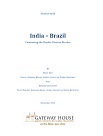Abstract
When the term BRIC was first coined in 2001, Brazil and India were reputed as two leading emerging markets with tremendous growth potential. While both nations have sustained high growth rates for almost a decade, both are increasingly facing the onerous double disease burden that could prove to be economically and socially crippling if left unchecked. The double disease burden refers to the rise of communicable and non-communicable diseases (NCDs). Inefficient healthcare delivery systems and high rates of urbanization have contributed to periodic rises in communicable diseases such as tuberculosis, malaria and HIV. At the same time, as life expectancy increases in both nations, there has been a concomitant hike in the prevalence of NCDs such as cancer, diabetes and cardiovascular disease.
This double disease burden is a common characteristic of developing nations and the increasing morbidity and loss of economic activity has the risk of hampering economic growth. According to the World Health Organization (WHO), the estimated loss in income from heart disease, stroke and diabetes alone was $8.7 billion in India and $2.7 billion in Brazil in 2005. This is expected to increase to $54 billion in India and $9.3 billion in Brazil by 2015. By implementing proper policy measures, both Brazil and India can avoid a health care catastrophe and serve as a model for developing nations.
There is no doubt that Brazil has outperformed India in terms of controlling the spread of communicable diseases. Yet, challenges remain. While rates of HIV/AIDS and tuberculosis are comparatively lower in Brazil than in India, rates of dengue fever in Brazil are six times higher than they were in the 1990s, with 3.5 million cases in the last decade and no available vaccine (Barreto et. al, 2011). Control of neglected tropical diseases such as visceral leishmaniasis is also currently very poor.
India has an even more unsettling disease profile with major diseases like tuberculosis responsible for more than 300,000 deaths per year. In addition, while the government boasts a reduction in prevalence rates of HIV/AIDS, it is still home to over 2.4 million HIV/AIDS patients.
Equally worrying is the monumental rise in rates of cardiovascular disease and diabetes. According to the WHO, non-communicable diseases currently cause 35 million deaths per year and 80 percent of these occur in low- or middle-income countries (World Diabetes Foundation 2010). India will incur an accumulated loss of over $200 billion due to non-communicable diseases by 2015, and Brazil will see an estimated loss of $49.2 billion due to diabetes and cardiovascular disease alone (World Diabetes Foundation 2010).
It is clear that Brazil and India will not be able to achieve the Millennium Development Goals by 2015 unless the double disease burden and associated challenges of alleviating the rising economic and human costs are addressed. Overall, Brazil’s efforts and programs have been more effective than India’s. Brazil’s acceptance of health care as a constitutional right for all citizens in 1988, regardless of their ability to pay, has led to groundbreaking health care reforms by the Brazilian government. Its HIV/AIDS program has served as an exemplar of government intervention. In the 1990s, the World Bank had estimated that 1.2 million people would be living with AIDS in Brazil by 2000, but in reality, the actual figure was less than 600,000 due to effective government intervention (Avert n.d.). India however, still struggles with a lack of effective communication between federal, state and municipal governments and woeful implementation of health coverage across sectors. Since India has a disproportionate share (21 percent) of the global disease burden, it is essential that it learn from Brazil a country that has achieved several significant milestones in addressing the health care needs of its citizens who are below the poverty line. India could adopt similar health care strategies to promote collaboration between the two nations to combat the double disease burden.
You can download the PDF version of this essay, here.
Mohit Nair is a Research Intern, Gateway House
Abhijeet Deshmukh is a Term Member, Gateway House
This essay was exclusively written for Gateway House: Indian Council on Global Relations. You can read more exclusive content here.
For interview requests with the author, or for permission to republish, please contact outreach@gatewayhouse.in.
©Copyright 2011 Gateway House: Indian Council on Global Relations. All rights reserved. Any unauthorized copying or reproduction is strictly prohibited.



